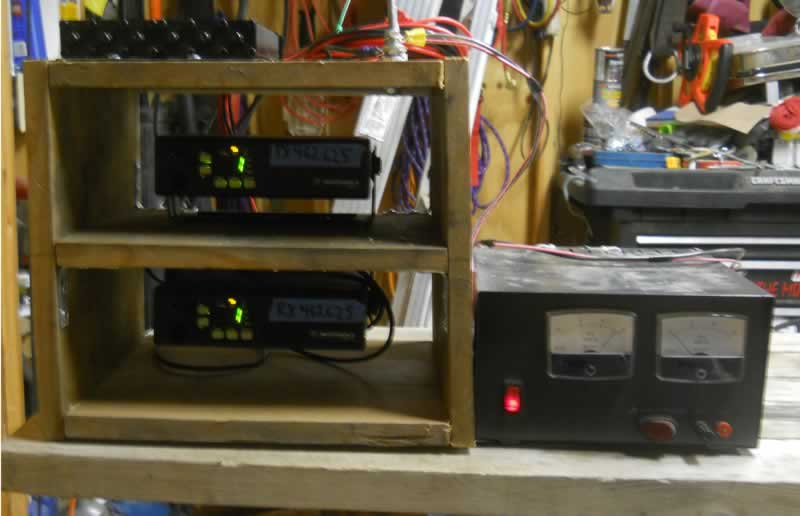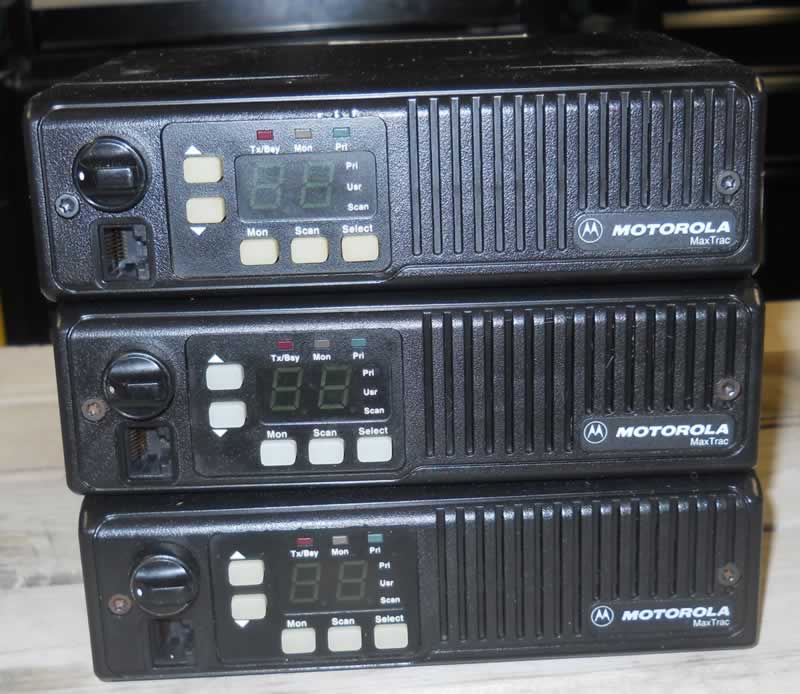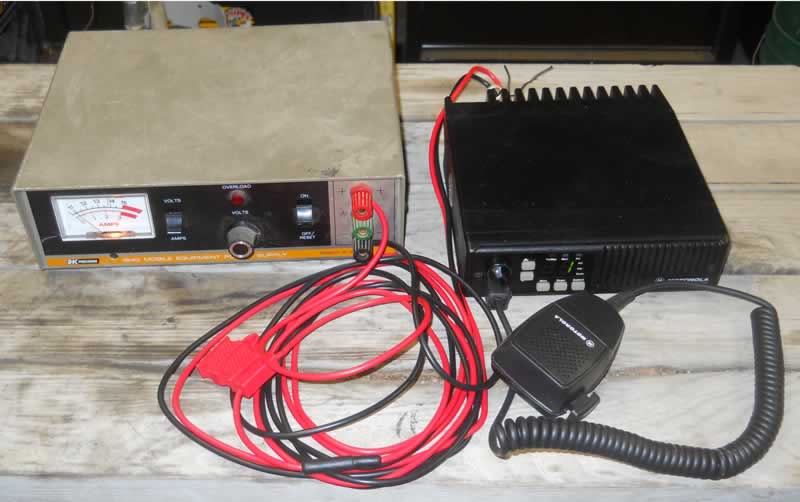GMRS repeater I built
with almost all Ebay partsWhy GMRS?
I had some spare funds and decided to try again at building a GMRS repeater. A couple of years ago the some aftermarket Motorola Radio Interface Boxes have become available on Ebay that allow me to program the old Motorola radios instead of having to take them to a dealer, and the RIB cable only cost about $30. And you can also buy a pre-made repeater cable off of Ebay that plugs directly into a 16 pin Motorla Maxtrac radio and presto, you have a repeater.
So this is the route I decided to go, the Motorla Maxtracs can be had for about $60 on ebay, the repeater cable was $30, and the programming RIB was $30. A couple odds and ends and I should have a working repeater for about $200 using some parts I have from the other repeaters I have built.So here is what I got:
Three Motola Maxtrac radios
All three radios came complete with power cables, mounting bracket, and microphone. And the radios were in really good shape for $160 for all three. I only needed two, but the third was a good test and experimentation radio (Which proved to be very helpful in troubleshooting)Specifications of the repeater:
Two 25 watt Motorola Maxtracs with 16 pin connector, model #D428ASC radios connected together with arepeater cable from Ebay and a Duplexer tuned for GMRS frequencies.
The radios are 30-50 watt output and the frequency range on these radios is 403-470 mhz. The radios pull about .33 amps per radio, so it should pull about .66 amps at 12 volts while at idle.Frequency info
TX= 462.625 - Repeater Out
RX= 467.625 - Repeater In
PL= 100.0For Motorola T7200's
Channel 18, Sub Code 12
For a normal radio
For a ham radio to 462.625 with a positive 5 mhz offset and a 100.0 pl tone
The call letters for my repeater is WQTC540
A couple of tips I learned programming these Maxtrac radios:
You have to run the Motorola RSS on MSDos on a real pc or laptop. It will NOT work if you try to use virtual PC, dosbox, or any other emulation/virtualization software. It will also not work with a USB serial port adapter. You have to have a PC running old DOS.
I thought I was smart it and get the software to work in Dosbox with a USB serial adapter. It will not work, despite numerous attempts (Spent almost an entire day working on this) You can get the software to run but when you tell it to read the codeplug from the radio, it simply will not communicate with the RIB. You simply have to run it in DOS.
A windows 95 boot disk will work, just go into DOS mode. I used a P4 laptop running windows 95 in DOS mode and was able to run the software.
Once you have an OLD PC functional, simply plug it into the mic port and start programming.
Simply plug in the cable, you don't have to worry about putting the radio into program mode, just plug it into the mic port and you are good to go.
I did encounter a problem after getting the radios programmed. PIN #8 on the reciever needs to put out a signal telling the controller that it is recieving a carrier operating signal (COS for short) In the programming, you have to go in and make sure pin #8 is set to output on the PL tone, otherwise the repeater cable will never get the message to TX the TX radio.
To get a neat squelch tail, you need to enabling signaling and ID using mdec.
Overal build cost:
$140 - Radios
$30 - Repeater cable
$30 - Programming cable
$90 - Duplexer
$60 - Power supply
$40 - Antenna
$390 - Total cost

and I built a wood box to get all of the gear mounted in
to make it more portable

Results:
So far, this is the best repeater I have built. Early tests show a range of almost 2 miles, in an urban area with the antenna only 15 feet above ground level. So this repeater has gone about 20 times farther then any other repeater I have owned before. Definately an accomplishment.
I did have a little bit of trouble with RF interference with the repeater controlling circuit, it kept the TX radio transmitting non-stop, simply moving the coax fixed this problem.
The transmitter radio gets warm fast, from cold, transmitting for 60 seconds gets the heat sink to 110 F, I should look into getting a fan installed.Future plans:
I plan to do more testing range and and power consumption of the repeater. Now that its mounted in a box, its easy to rig it up on a mountain top and test range.
Get a fan installed to keep the transmitter cool.
Maybe try to see if I can get this radio to run off of solar power.
Maybe get a real repeater controller rigged up to these radios so it will properly ID itself, make announcements,
My long term goal is to get better at building these repeaters so they can be used for public events.Testing results:
I took the repeater, rigged it up to my solar battery pack, and hauled it up to the top of a ridge on a foggy cold day. The road up was pretty muddy, but I got it up there and did some testing. I was able to get a 10 mile range from the transmitter, but I think I have some problems with the audio coming through. Need to do some more testing, on a warm and clear day. Also need to put a sign on my equipment so people wandering the back roads will leave my equipment alone.Registered on mygmrs.com
I got this repeater registered on the mygmrs.com site here

